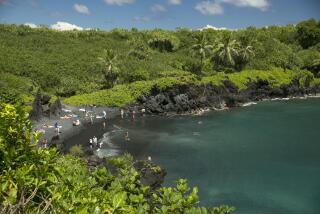Michigan Park Has No Roads and Few People
- Share via
ISLE ROYALE NATIONAL PARK, Mich. — No cars, no roads, few people.
Not the usual description of a national park in the middle of summer. But try to imagine miles of empty trails through forest underbrush laden with wildflowers and ferns.
Add more than occasional glimpses of moose, foxes and wolves. Then, surround the entire picture with clean, brisk air and crystal clear waters and you’ll find yourself in Isle Royale National Park.
Accessible only by boat or floatplane, the park is 18 miles from the nearest land (Canada) and is comprised of one large island and more than 200 smaller isles in Lake Superior’s northwest corner.
Four hours by ferryboat from Copper Harbor, Mich., or Grand Portage, Minn., or 30 minutes by floatplane from Houghton, Mich., Isle Royale National Park is a wilderness archipelago of unspoiled forests surrounded by deep cold waters and laced by more than 166 miles of foot trails.
Except for birds, only wildlife able to swim, drift across the water or cross the ice in winter inhabit the islands. Moose, beaver, wolf and red fox are the dominant animals and are common sights along the trails.
Unlike at most national parks where people outnumber wildlife, at Isle Royale hikers can walk undisturbed for hours without meeting another passerby, and only then perhaps encounter a ranger ensuring that trails are clear of fallen trees from the frequent summer thunderstorms.
Rare wildflowers such as the miniature lily of the valley and the bright orange island day lily provide splashes of color along the trails through lush undergrowth of ferns interspersed with junipers, aspen and birch.
Off-trail hiking is not recommended because of the dense vegetation, bogs and warm-water swamps.
A bird-watcher’s paradise, the islands are home to more than 200 species including loons, bald eagles and ospreys.
Smoothed, rounded and grooved rocks meld into rugged cliffs on one side of the main island, evidence of glaciation as the lake level dropped.
Small linear hills dot the southwestern part of the island and thick pine forests surround small pits in the rock where Indians mined copper beginning about 2000 BC.
Freshwater lakes, streams and ponds create a unique environment in which an estimated 80% of the park is underwater. However, swimming is discouraged due to leeches in the warm-water areas and bone-chilling water in the lake.
Scuba divers must register with park officials. Generally, visitors must be content to enjoy the waters from trails or boats.
Open from June through Labor Day, Isle Royale has something for everybody: campsites for backpackers; housekeeping cabins in the pines for those who prefer a semi-rustic approach, or Rock Harbor Lodge offering ‘5Os-era rooms, each with a private bath and picture-window view of lake.
At Rock Harbor, the only inhabited part of the island chain, one small store sells camping provisions and the park-concession marina provides fuel for boats.
Except for an information center and grocery/boat rental area at Windigo at the opposite end of the island, no other commerce is evident. If you don’t bring it with you to Isle Royale, you may have to live without it.
The National Park Service brochure says, “Isle Royale is an island in time, a natural space in which you operate on natural time and experience the rhythms of light and dark. Days are measured in footsteps.”
With that philosophy in mind, rooms at the lodge have no telephones, radios, televisions or clocks. Only the water’s gentle lapping at the shore breaks the silence. Birds provide the island’s only wake-up calls; the sun’s angle indicates the time of day.
The absence of cars and roads seems perfectly congruous, the only intrusion of mainland noise coming from the Lodge’s green tractor hauling cargo and luggage from the ferryboat dock once a day. Pets and bicycles are also prohibited on the island, adding further to its quiet and calm atmosphere.
Fishing is considered good throughout the summer, and small boats and canoes can be rented at Rock Harbor. Canoes can also be brought to the island on the ferryboat for an additional fee. Brook and rainbow trout, northern pike, walleye, yellow perch, whitefish and herring abound.
Lunch ($7) and dinner ($15) at the Rock Harbor Lodge Restaurant include at least one fresh-fish selection daily, usually herring at lunch and lake trout for dinner.
Evening entertainment in the Rock Harbor area comes from ranger talks in the forest amphitheater or sunset strolls along the shore. A family of red foxes housed in a den near the Lodge regularly appears at dusk to frolic and delight passersby.
While most visitors look forward to unwinding from the hectic pace of mainland life, some businessmen and women addicted to telephones--even while on vacation--may suffer withdrawal symptoms since no public phone exists on the island and only emergency messages can be transmitted via the Lodge’s office telephone.
“Getting away from it all” is literal at Isle Royale.
Beware: No Phones or TV
Getting to Isle Royale National Park: Round-trip ferryboat fares from Copper Harbor or Houghton are $60 per person. The one-way journey takes 4 1/2 hours. One-way trips via floatplane are $75 and take about half an hour.
Floatplane reservations: Seaplane Service, Box 371, Houghton, Mich. 49931, (906) 482-8850.
Accommodations: Rock Harbor Lodge rooms are $145 per night, double occupancy, including three meals.
For more information: Contact Isle Royale National Park, P.O. Box 405, Houghton, Mich. 49931, (906) 337-4993 (summer) or Mammoth Cave National Park, Mammoth Cave, Ky. 42259, (502) 773-2191 (winter).
More to Read
Sign up for The Wild
We’ll help you find the best places to hike, bike and run, as well as the perfect silent spots for meditation and yoga.
You may occasionally receive promotional content from the Los Angeles Times.






